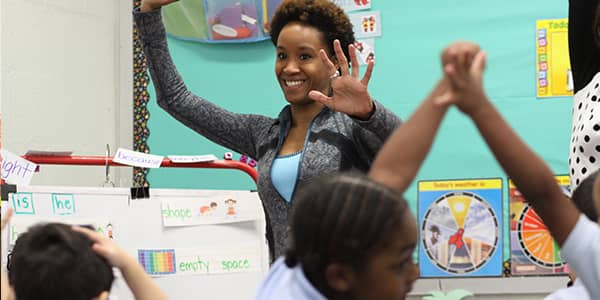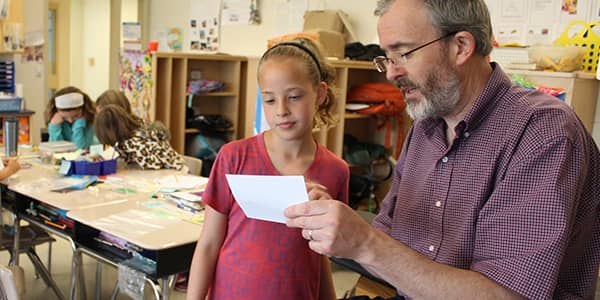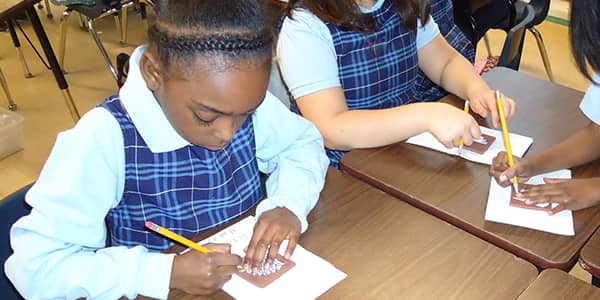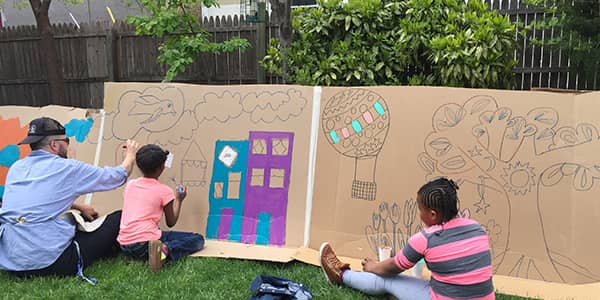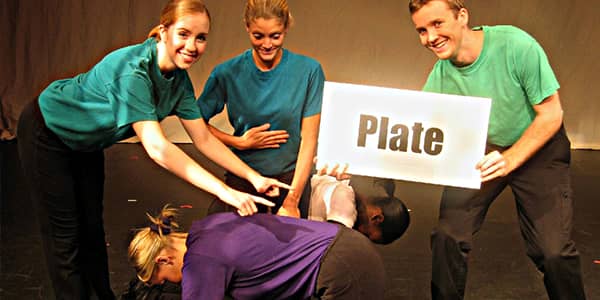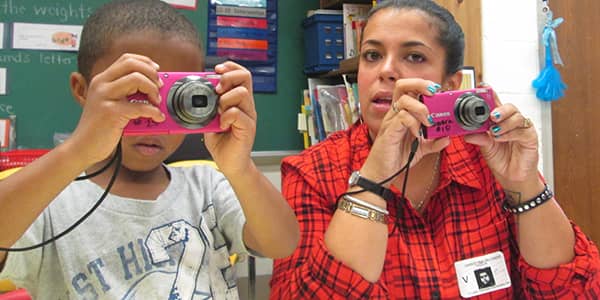Blog
YA Forges New Arts Integration Partnership

A teacher from Oxon Hill Middle School personally thanked Young Audiences during a post-event gathering for bringing the Literature to Life program to Prince George’s schools. After a performance of “Black Boy,” a verbatim adaptation and stage performance of the classic American literary work by Richard Wright, he said he saw one of his students carrying around the Richard Wright book. When he asked the student about it, the student said he decided to read it after seeing the performance. The teacher noted that he didn’t read that book until college and said, “This is what Young Audiences does for our students.”
On November 17, Young Audiences of Maryland and Dr. Kevin Maxwell, CEO of Prince George’s County Public Schools (PGCPS), announced the launch of a new arts integration partnership at a press conference held at Oxon Hill Middle School.
This new initiative will benefit more than 15,000 Prince George’s County Public School students in the 2015-2016 school year and dramatically increase student student access to the arts.
Dozens of teachers, principals, and PTA members were in attendance, along with school board members and PGCPS district office personnel. The event attracted the attention of local media outlets, including WUSA, a CBS news affiliate station in Washington, D.C., who ran a segment on the new partnership during their morning news coverage on November 17.

In the true spirit of Young Audiences, this was not your typical “black-tie” press conference. The room was filled with music, dance, laughter, and inspiring stories. Student performances from Oxon Hill Middle School’s Performing Arts Academy opened the event, showcasing the talents of the school’s students through music and dance performances. Young Audiences’ teaching artist Ssuuna engaged the audience in an interactive, call-and-response performance of music from his native Uganda with authentic African instruments.

With media cameras rolling, Dr. Maxwell spoke passionately about the importance of partnering with Young Audiences to bring high-quality arts programs to more PGCPS students. Integrating the arts into classrooms is not only critical to increasing student achievement and engagement; it is an essential component of every student’s education and maximizes the talents of all students. Dr. Maxwell’s belief in the importance of the arts-in-education—and the exceptional teaching artists and arts-in-education programs that Young Audiences provides—will ensure that all students have the opportunity to experience this critical part of their education.
Stacie Evans, Young Audiences’ Executive Director, echoed Dr. Maxwell’s remarks, saying:
We believe that artists are catalysts in our schools. Through their art form they develop new approaches to teaching the curriculum. They inspire children. They help reach the most reluctant and struggling learners. From the beginning, Dr. Maxwell made it clear that the arts are a priority and he welcomed community partners to be part of the solution to ensure that our kids receive a complete education. As a result, 15,000 more students are benefiting from Young Audiences programs this school year alone.
Additional speakers included Mr. Wendell Coleman, Oxon Hill Middle School Principal; John Ceschini, Arts Integration Officer for PGCPS; and Tracey Cooper, Oxon Hill Middle School science teacher.

Young Audiences’ teaching artist Kevin Martin closed out the event with a steel drum ensemble of Oxon Hill Middle School students. These students—who jumped on stage to perform just hours after learning to play the steel drums—soon became the teachers. The steel drum performance culminated with Kevin inviting audience members, including Dr. Maxwell, to join a student at their drum and follow the student’s lead in learning the song.
A teacher from Oxon Hill Middle School personally thanked Young Audiences during a post-event gathering for bringing the Literature to Life program to Prince George’s schools. After a performance of “Black Boy,” a verbatim adaptation and stage performance of the classic American literary work by Richard Wright, he said he saw one of his students carrying around the Richard Wright book. When he asked the student about it, the student said he decided to read it after seeing the performance. The teacher noted that he didn’t read that book until college and said, “This is what Young Audiences does for our students.”

From theatrical productions that bring American literary masterpieces to life, to artist residencies for kindergarten students that inspire environmental citizenship, this new partnership with Prince George’s County Schools significantly increases access to arts learning for thousands of PGCPS students and leverages the talent of 20 teaching artists, the resources of six private and public funders, and advances the goals of PGCPS and YA to transform the lives and education of all students through the arts.
Research shows a direct connection between participation in the arts and student achievement. Research also shows having the arts in schools contributes to positive school culture and builds the creative and critical thinking skills that our workforce needs. Despite these benefits, student access to the arts as part of their education has declined. Young Audiences is honored to partner with Dr. Kevin Maxwell, named a Champion of Change by President Obama for his dedication to the arts, because he is committed to ensuring that PGPCS students are not denied the arts as part of a complete education.
Powering Arts Integration with Innovative Programming
Young Audiences’ programming for PGCPS will combine arts learning with traditional subjects such as science, math, and reading, expand in-school opportunities for professional teaching artists, and include further arts integration advancement through strengthening teacher preparation and professional development. Program areas to include:
GROWING UP GREEN
A Kindergarten-level environmental literacy program that supports a thematic approach and addresses the Maryland Environmental Literacy Curriculum Standards. Curriculum will be developed collaboratively among partner organizations and, following a successful pilot of the program, will later be infused into the kindergarten science and social studies core content areas. Financial support provided by BGE, Chesapeake Bay Trust and Maryland State Arts Council Artist in Residence Program.
LITERATURE TO LIFE
Through our unique combination of interactive theater, literature, and education, Literature to Life brings American literary masterpieces to life —giving voice to words and inspiring young people to find their own voice. Financial support provided by Laura Handman and Harold Ickes, Lisa and Porter Dawson, and other generous supporters.
PROFESSIONAL DEVELOPMENT
A series of professional development workshops designed for schools in their first year of joining the “Arts Integration” initiative. Educators will define and discuss the benefits of arts integrated teaching. After experiencing a sample drama and language arts lesson, teachers will brainstorm and apply creative challenges in their specific curriculum area. Program facilitated by Teaching Artist Institute.

Welcome to the Summer Arts Academy 2015!
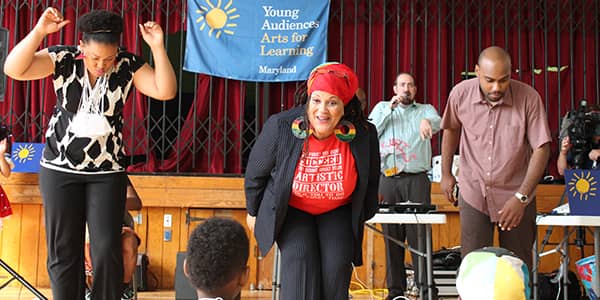
Young Audiences has again partnered with Baltimore City Public Schools to make sure that arts-integrated learning does not end with the school year. On Monday, June 29, energy filled the gymnasium of Thomas Jefferson Elementary/Middle School as Young Audiences artists greeted 250 Baltimore City students and their families with high-energy performances, live music, and vibrant interactive art demonstrations during the kick-off assembly of the Summer Arts Academy.
The Academy is a five-week, city-wide program that provides students, third-grade through seventh-grade, with a free once-in-a-lifetime opportunity to spend their summer learning from the talented artists who live in our communities. The Academy was created as part of City Schools CEO Dr. Gregory Thornton’s plan to increase arts education opportunities for Baltimore City students. The Academy’s literacy component, with the overarching theme of “What Makes a Hero?” will be team-taught through the arts by City Schools teachers and faculty artists specializing in visual art, sound production, clay, African Drumming, modern and African dance, and improvisational and urban theatre. The Academy also gives students the opportunity discover art forms they have never experienced before and delve into two artistic disciplines of their choice. Students will perform at Artscape and visit other arts destinations through field trips. See the full list of the Academy’s artist faculty here!: Summer Academy Artists

See more photos from the Summer Arts Academy kick-off assembly here!
Hip Hop musician Jamaal “Mr. Root” Collier set the stage for the crowd during the Academy’s kick-off assembly. Joined by another Young Audiences musician, Kevin Gift, on the turntables, the performance used high-energy beats, improvised rapping, and beatboxing to get the crowd swaying and dancing. A couple of shy boys watched from afar, but slowly began to inch their way toward the booming set with growing curiosity.
Nearby, the dance moves of Cynthia Chavez of Baltimore Dance Crews Project (BDCP), caught the eye of three girls who were interested in learning how to moonwalk. Cynthia worked through foot techniques and demonstrations until the girls were ready to try it themselves.
Filmmaker and photographer Ras Tre showed one intrigued student how he operates his professional video camera equipment.

Artists, students, and family members began to gather on the dance floor as the popular music began to flow out of the speakers. One talented student stepped toward the center of the floor with confidence. He began to lead the choreography of one popular song while the crowd stepped back, learned the moves, and cheered him on. This encouraged other nearby students and artists to join in until the entire dance floor was full.
The assembly wrapped up with artists, teacher partners, and other Academy staff introducing themselves by dancing onto the stage. As students broke off into their grade-level groups, one parent asked: “Is there an adult Young Audiences class that the parents can take? We want to have this much fun, too!”

On average, all children can lose approximately two months of learning from the previous school year during the summer months without engaging education activities, and for low-income students, the loss is even greater. More than half of the achievement gap between low-income students and their more affluent peers can be attributed to the unequal access to summer learning opportunities. Programs like the Summer Arts Academy provide students with a safe place to go during the day, access to free healthy meals, adequate adult supervision, and positive, educational activities.
The high-energy kick-off assembly was only the beginning of what is to be expected this summer. Be sure to follow the Young Audiences blog, as well as our Facebook page, for updates from the Summer Arts Academy throughout July.
Creative Movement: Movimiento Creativo
By Valerie Branch, Young Audiences and Maryland Wolf Trap teaching artist
Empowering youth through my art form is something that I’m very passionate about. As a dance teaching artist, my role in the classroom is to enhance students’ development in decision-making, communication, and self-confidence through individual and shared movement explorations and experiences. Students learn how to control their impulses and self-manage when it is time to be silly and when it is time to stop and focus.
I recently completed a year-long Maryland Wolf Trap residency at Holabird Academy with teacher partner Ms. Katie Fincke and her pre-kindergarten class of students ages three to six. Our residency specialized in Language Arts with a focus on narratives and storytelling, so Ms. Fincke and I found ways to integrate movement experiences into the curriculum.
We accomplished our major teaching goal by using the elements of dance to help children convey meaning. We did this through a series of six different books that Ms. Fincke read with her students throughout the year. Ms. Fincke and I guided the children through the process of generating imaginative ideas about how to portray and connect to moments in the story through movement. Ms. Fincke’s class had many students whose first language was not English, so our goals uniquely overlapped with language development and vocabulary enhancement.

Ms. Fincke and I wanted the children to define and understand the meaning of creative movement. Our dancing activities did not follow the typical routine of me modeling a movement and students mimicking me. It was more about finding a way for me, Ms. Fincke, and the students, to have the experience together. Ms. Fincke and I didn’t want to robotically lead the children by saying, “Arm up, arm up, down, turn, turn!” Instead, it was the children leading us. We would hear, “No, let’s do our arms like this!” or “Let’s move like this! Let’s go here!” Students were given the chance to be creative and collaborate with their teachers and their peers. They were empowered to speak up and share their ideas because dance has no wrong answers. We encouraged our students to improvise without fear because we wanted them to know that their thoughts and ideas were valued. It’s a scary thing to express yourself with your body in front of a crowd. We wanted them to find a comfort level that would allow them to express themselves without limitations.
When I first walked into Holabird Academy, many of the students struggled with understanding personal space, body impulses, and self-confidence in creating and sharing ideas. Ms. Fincke and I have seen so many students flourish during the course of our partnership, but one student who made tremendous strides in social development and leadership was Oscar. We have watched Oscar become a leader and set a great example for his peers. He was never afraid to demonstrate his ideas through dance. He encouraged his peers to make strong independent choices. His classmates have been able to take risks and explore their creativity because they saw Oscar doing just that. Oscar demonstrated his leadership through an activity called the “mirror game,” which required students to slow down their energy and express themselves through dance in a calm and channeling way.

During the mirror game, one student at a time would face the class from the front of the room and then create slow movements with their body. The goal was to get the rest of the class to slowly repeat the leader’s movements as if they were the reflection in a mirror. Oscar really took interest in this activity and whenever he was up at the front of the room, he made sure that his movements were clear for his classmates to follow. Because he took the activity so seriously, there were times when other students would poke fun at him, but he didn’t let it bother him. A great leader is not somebody that forces their own ideas on people, but explores how people can share ideas together. Oscar led this activity with the intention to work with everyone as a team and that trait was very admirable.
What I loved most about working with this group was that I was not only able to teach them, but they were always teaching me. During the first few sessions, we would sing a greeting song in English, but by the third class, I had introduced the song in Spanish, a language I knew most of Ms. Fincke’s class was familiar with. Suddenly, the looks on their faces changed and they realized they knew the words. The kids lit up with excitement when they felt that sense of home and comfort in the classroom. Ms. Fincke and I always took time for the Spanish language and that was important to her students. It was also crucial for Ms. Fincke to take time to do translations and have the kids work together through their language differences.
It was important that we did not tell them to always speak English. Yes, we were in an environment where English was the primary language, but we also wanted them to hold strong to their heritage. Seeing them take ownership of their language was inspiring. We often let them sing and dance in Spanish and those were truly their moments to shine and demonstrate how far they were excelling in the knowledge and understanding of the skills we were sharing with them.
It’s been amazing to watch these students grow, interact with one another, and also feel better about themselves. It’s important to get them thinking about these things at an earlier age because I think that we often forget that children can have problems and stresses, too. We think that they don’t have any issues because they’re young, but our youth go through so much. They are witnesses to everything. They may be young, but they are just as much a part of our world as we are. Using dance and movement to build our youth into better citizens is something that empowers me as an artist.
Learn more about Valerie Branch and her dance programs for schools.
Create easy, DIY books

In our June smART Tip, Young Audiences Chief Innovation Officer Pat Cruz shows you how to make a book out of one piece of 8.5×11″ paper. Press play to get started and learn how this arts enrichment exercise can be used in any classroom!
smART Tips is a monthly video series sharing tips for educators who are interested in new, creative ways to use the arts in their classroom with students. See all smART Tips to date here. Interested in a specific topic? Let us know!
Communicate ideas through tableau

Our May smART Tip comes from Young Audiences Arts Integration Specialist Kristina Berdan. Press play to learn how you can easily incorporate theatre into your classroom by challenging students to communicate main ideas and supporting story details through tableau.
smART Tips is a monthly video series sharing tips for educators who are interested in new, creative ways to use the arts in their classroom with students. See all smART Tips to date here. Interested in a specific topic? Let us know!
Sing it loud!

By Alden Phelps, Young Audiences artist and musician
My work as a teaching artist focuses on collaborative songwriting with children. The goal of my recent residency at Triadelphia Ridge Elementary School was to teach seven different classes of third and fourth graders how to create parodies of current pop songs that show their knowledge of science and history.
Teaching musical parodies is a great way for students to learn because it’s an opportunity to share their knowledge in a creative way. Students synthesize their knowledge of specific subjects with poetry in a song. There are several layers of learning going on, including using their knowledge of the curriculum, organizing ideas, and employing multiple Language Arts skills.
I worked directly with Triadelphia’s teachers to strategize how to address their needs through music by discussing their most recent units and the related curriculum standards. My customized arts-integrated residency addressed what the teachers wanted to focus on, namely a third grade unit on earth science and a fourth grade unit on Maryland history. The goal is always to reinforce what students have already learned through this new artistic skill.
The advantage to using current pop songs such as “Shake it Off” or “All About that Bass” is that the kids recognize the tunes immediately. I do background work to make sure all the songs will work in this unique collaborative project. Students always express an immense level of enthusiasm whenever I walk in with a list of handpicked songs they could use for their parody. For example, Mrs. Russell’s third grade class chose the hit “Call Me Maybe” by Carly Rae Jepson for their parody about weather patterns. In the end, their song was titled “Save My Granny,” and it describes several different extreme weather patterns in a clever and funny way.
I began by teaching the children basic elements to songwriting and composing. We did this by counting the number of lyrics, verses, and choruses of their song choice. Through this analysis, we discussed each song’s use of patterns, syllables, rhythms, and accents. I then divided the children up into writing teams so that they could begin building the verses of their songs. This activity is always a great teaching moment because it challenges students to collaborate, share, and compromise with one another while being creative. I spent time with each writing team and coached them through the creative process. While they worked independently, I provided them with rhyming dictionaries and was surprised by how quickly they dug into those books! Rhyming at that level is a fairly difficult skill for children to master in such a short period of time.

The writing process is always satisfying to me because I get to witness students discover a whole new world of words they may not have even realized existed. I often came across students who struggled to find rhyming options with difficult words. But then, just like that, a kid would blurt out the perfect lyric that would fit. A line would just tumble out of their mouth and I’d shout “Yes! That’s it!” In response, they would light up with excitement knowing that they had the answer within them all along, they just had to let it out.
In one of my classes, there was a child who consistently struggled with behavioral issues. During this residency, he collaborated well with others and even wrote a clever lyric which became the opening line of the parody. Collaborating with the team was a huge step for him.
As final preparation before each group was to perform their parodies for the school, students typed up each song’s verses with the teachers, practiced singing their lyrics, and made final tweaks to the lyrics, changing a word here and there. Before their eyes, songs emerged–there’s always electricity in the air when a class suddenly realizes what they’ve achieved. The Triadelphia students were so proud of their final products and knew that they had created something clever and unique.
Because children spend so much time with their peers in schools, I believe that it’s important for them to interact with many different kinds of people, including artists. Artists are a unique breed–if nothing else we have a different perspective on the world, and through the arts, anyone can see through different eyes. Creativity is a way of seeing life from different directions and a way to find a thread connecting disparate ideas. The way artists go about solving problems and finding meaning is important for children to experience. It gives them opportunities to see through new eyes, and speak with a new language.
Learn more about Alden and his programs for schools at yamd.org. Read the full lyrics of the parodies Triadelphia Elementary students wrote by visiting aldenphelps.com.
Hands-on learning through arts integration
By Christa Huber, Arts Integration Coach, Patterson Park Public Charter School
I have been with Patterson Park Public Charter School for six years in various teaching positions in Title I, third grade, the English for Speakers of Other Languages (ESOL) program, and am now the school’s arts integration coach. This year has been a learning process, but also such a positive experience working in partnership with Young Audiences and Arts Every Day.
It was a personal goal for me to transition Patterson Park Public Charter School into becoming an arts-integrated school. I wanted to maximize our artist-in-residence programs with outside artists as much as I possibly could this school year. We believe in the strength of the impression that residencies make upon students and teachers. All of the work that comes out of a residency versus a day-long field trip makes such a difference. Residency programs allow students more time to engage with and learn from the artists. This exposure to artists is also important for the teachers because it provides a longer period of professional development so that they can learn skills and strategies that they can carry out in the future.
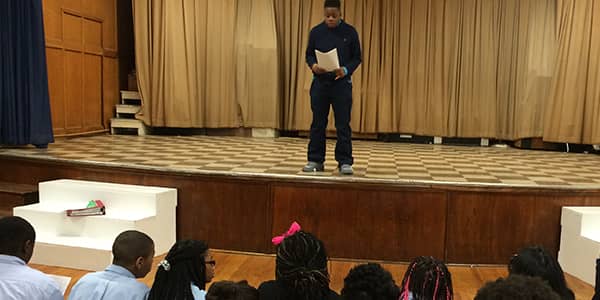
We had a fantastic variety of Young Audiences artists out to our school this year. These artists included: spoken word poet Femi the Drifish, ceramic visual artist Amanda Pellerin, Baltimore Improv Group, Flamenco dancer Anna Menendez, and more. These programs were made possible through Access for All grant funding from Young Audiences and funding from Arts Every Day.
We spread the residency experiences across different grade levels of the school. It was very helpful having the Young Audiences artist and program information online because it allowed me to search for artists that matched and linked to the content areas that our teachers were looking for.
There were a variety of stand-out experiences from our residencies, but here are a few:
- Femi the Drifish worked with our middle school students in Language Arts. A great thing about that residency was the response we received from students who typically are not comfortable with performing in front of people. By their culminating performance, those students in particular were the ones to stand up and share their poetry with strength.
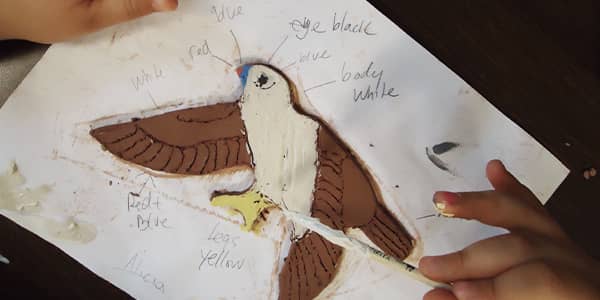
- The third grade worked with Amanda Pellerin to create an Ancient Egyptian mosaic. This piece of work related to their study of the ancient civilization. Mr. O’Connell, our third grade science and social studies teacher, was blown away by how Amanda challenged the students to do their best work in a really positive way. We’re very excited to have that piece of artwork as a permanent fixture in our school.
- Anna Menendez brought some of the Spanish culture into our school. Some of our middle school students had just returned from a trip to Spain during spring break, so this residency was another way to connect with what they learned and saw on their travels. It also provided a relatable experience for the students who didn’t have the chance to travel to Spain.
I have personally seen the impact that residencies have had upon teachers compared to other arts-related experiences. I believe that having artists at Patterson Park helped our teachers develop a great deal. Artists exposed teachers to new art forms that they may not have had any experience with, such as spoken word poetry or improvisation, and gave our teachers opportunities to learn how to tie these art forms to the curriculum.
One of our charter school philosophies is that children learn best through hands-on activities with interdisciplinary and semantic learning models. Arts integration is at the core of our values and it naturally makes sense for Patterson Park.
Spreading hope through art

By Jessica Porter, Young Audiences Program Director
Tuesday morning in Baltimore began with a somber tone. As community members cleaned up our streets, led peaceful demonstrations, and opened their doors to their neighbors who needed a place to go, reflect, and process, something beautiful began to happen.
Early on in the day, I was struggling to find ways to productively volunteer. Despite our initial frustrations, the Young Audiences staff worked collaboratively with each other and with our artists to identify ways to positively affect the lives of quite a few people in meaningful, creative, and important ways throughout the day.
Young Audiences’ musician Kevin Martin volunteered to provide his Steel Drum Experience program, with children and volunteers who were spending the day at The 29th Street Community Center. Our very own Chief Innovation Officer Pat Cruz and several Young Audiences staff partnered with puppeteer Michael Lamason to get arts activities, such as mural painting, puppet making, and a free puppet show, off the ground at Black Cherry Puppet Theater.
This doesn’t even touch on the powerful work our artists were doing on their own! In a 10-minute span of the local news Tuesday evening, I saw at least four different artists I’ve worked with in some capacity during my time at Young Audiences right in the epicenter of the healing taking place in our city. Having long been active members of the communities in which they live, many of our artists are poised to lead the change that our city deserves.

When Kevin called me to say he was on his way to the 29th Street Community Center, I decided to come along. There were only about a dozen students at the center, and probably just as many volunteers, but seeing the smiles on those kids faces was the hope that I needed. I could tell the experience provided a much needed spark for the other adults too. The students chose to name our band “Monkey Kids.” Though we had only 40 minutes together, at the end we performed a rough rendition of the Toots and the Maytals’ song “Monkey Man”–and everyone walked away beaming.
Across town at Black Cherry Puppet Theater, more than 30 kids and parents gathered to draw, paint, and create their own puppets before a free puppet show mid-afternoon. This was a true community effort, as artists donated their time and volunteers contributed food and labor.
We’ve all got a lot of work to do in order to see the change our city needs, but I am more confident than ever in the transformational power of our work, and thanks to my experience, I am once again hopeful for our city’s future.

The positive side effects of the arts
By Donna Greenleaf, Coordinator of Gifted and Talented Programs, Dorchester County Public Schools, and Renee Hesson, Coordinator of Instruction for Fine Arts, Dorchester County Public Schools
Being on the Eastern Shore, Dorchester is relatively isolated from many of the cultural experiences available closer to the Baltimore-Washington area. With reduced opportunities to experience art, children and adults can become limited in their thinking and understanding of different art forms. Working with Young Audiences, we tried to find a way to make an arts learning program that was more lasting for Dorchester students. Last year, we developed an assembly and workshop model—something that was totally new to the schools in our county. In the past, we had only ever had large group assemblies. These performances felt like “one and done” experiences and it was hard to measure the impact of this limited exposure to the arts on our students. By adding workshop sessions, we were able to reach more students in a more significant way because they had a hands-on experience with Young Audiences performing ensembles WombWork Productions and Quest Visual Theatre.
This assembly and workshop model was successful, but we thought there was still more to be done to truly impact the culture and climate of our schools through the arts. Artist-in-residence programs have the feature of offering professional learning opportunities to teachers while providing ongoing workshop opportunities to students. Although this was the type of program we believed our schools needed for the arts to have the maximum impact, we told Young Audiences that there was no way that we would be able to afford it. But with Young Audiences’ help, we began applying for grant funding to help alleviate the cost and make it happen.
Beginning last spring, we wrote Maryland State Arts Council Arts in Education Artist-in-Residence Grants to bring programs to seven Dorchester elementary and middle schools of the 11 total schools in our district. To supplement this funding, we also applied for a grant from a local foundation, the George B. Todd Fund and for supportive funds from the local Dorchester Center for the Arts. We hoped to bring WombWork back to build on the work they did with our students the year before, as well as bring beatboxer Max Bent and Hip Hop poet Bomani to our students. These Young Audiences artists were chosen to address the specific needs each school had identified as a part of their school improvement plan, including interpersonal skills, bullying prevention, math, and language arts.

These programs were as much for the kids as they were for the teachers. When Max came to our elementary schools, his enthusiasm brought a lot of energy to the kids and appealed to those kids who needed a different kind of artistic outlet. His program crossed cultural stereotypes and appealed to a wide-range of kids—and adults. Our teachers were reluctant at first, but Max was able to bring everyone into the experience. During pre-program meetings with Max, teachers were impressed that he was able to speak their language. His art form became more than just a nice enrichment activity, but one that made a strong connection to curriculum. Max was interested in what specific units and standards the teachers were working on at the time, and how he could incorporate beatboxing. He wanted to do more than tie into grade-level concepts, but ensure that it was focused and timely in the curriculum. That approach enhanced the partnership feeling between artist and educators.
During the professional development workshops, Max showed teachers how beatboxing can uniquely link to fractions. It was a distinctive example of how educators have to challenge themselves to come up with new and unique ways to teach the material instead of the same ways they’ve always taught.
In another one of our schools, Mama Rashida and WombWork worked with one classroom that had a reputation for negative behavior and not staying on task when an outsider visited. When we visited this class to observe them working with Mama Rashida on the play they were creating to perform for their peers, every single student was engaged and working together on the activity. Mama Rashida’s knowledge of young people and how to quickly build relationships helped support our students emotionally so that the group could get to the important work of learning the language of virtues. This experience proved to us—and to the students—that they have the ability to be college- and career-ready middle school students. They now have a relationship with their classroom teacher that they may not have had without this program.
When Max’s residencies began, we thought kids may be reticent about getting up in front of their peers and performing. At both culminating events at the close of the residencies, there was an overwhelming show of hands of students who wanted to get up and demonstrate what they had learned. It was exciting to see our kids transform into performers and there was no judgment. Even when a child got up and made a mistake, other students didn’t call them out. They were supportive of each other. Seeing this program’s contribution to a positive school climate, as students worked together on projects and supported each other, was a wonderful side effect of our residencies this year.
Maryland State Arts Council (MSAC) provides schools with AiE grants to support artist-in-residence programs. These grants can subsidize up to 30 percent of the total cost of a Young Audiences residency program, including travel costs. The application deadline for programs occurring next school year is Friday, May 15, by 5 p.m. Read more about this opportunity at yamd.org.
Summarize math concepts with Hip Hop

Rhyming couplets are a great way for students to summarize their knowledge and demonstrate their understanding of math concepts. In April’s smART Tip, Young Audiences Hip Hop musician Jamaal “Mr. Root” Collier shows teachers how to get started!
smART Tips is a monthly video series sharing tips for educators who are interested in new, creative ways to use the arts in their classroom with students. See all smART Tips to date here. Interested in a specific topic? Let us know!
Meet Our Artists: Quest Visual Theatre

Young Audiences’ roster of artists continues to grow to encompass new artists, ensembles, and art forms, from slam poets to improvisers to Capoeira masters.
We’ll be regularly posting interviews with our artists, giving them a chance to share more about themselves and their experiences bringing their Young Audiences programs to schools. We recently sat down with Tim McCarthy of Quest Visual Theatre.
Why did you decide to become a Young Audiences roster ensemble and how does it align with Quest Visual Theatre’s larger mission?
I had known several artists in Maryland who were with Young Audiences and I began to investigate what the organization was about. It made me think about where Quest Visual Theatre was heading and I thought it was something worth pursuing because we have so much experience working with children.
We are an inclusive company. Deaf people are a part of everything we do everyday and we wish to celebrate the people who are in this world. That’s the world we want to live in and we wish to bring those experiences it into children’s lives.
Quest also uses visual theatre to cut across language and cultural barriers. All of our work is inclusive and accessible. Everything that Quest does reflects the company’s commitment to welcoming to all people. One program that reflects that is QuestFest, which is a biennial international visual theatre festival. Quest partners with area theaters, universities, and agencies to present performances, conduct approximately 20 residencies, and provide training in visual theatre. The QuestFest Community Showcase enables students who have participated in QuestFest residencies to share work that they created.
What has been the most memorable part of the programs you have brought to the students with Young Audiences?
I love what I’m bringing into the schools and seeing how engaged the students are. Quest does little warm-ups before each performance. We play a game like charades with the audience. We have the audience begin to guess what the actors are doing; playing baseball, football, or golf. That really gets the kids involved and excited.
Do you have a memory of when you felt that you has an impact upon a student or class?
Students usually don’t know how to approach our actors because they are deaf, but after a performance or residency, we intentionally spend time and stick around to interact with the children. That’s when the hugs begin to happen. Things really change at that point. They see our artists as people they want to interact with. The communication barrier goes away.

How does your art form help connect students to what they are learning in school ?
Our goal is to integrate theatre into the curriculum. We do this by focusing upon two primary areas, including learning readiness and literacy.
How do the lessons that you teach students apply to and affect their everyday lives outside of the classroom?
In addition to learning the art form, the developmental skills we are focus on are communication and interpersonal skills. When you’re creating something and working in collaboration with others, especially if you’re not able to speak, you’re going to have to be clear about what your intentions are. Our lessons teach children how to send and receive information clearly with engagement.
Learn more about Quest Visual Theatre‘s offerings through Young Audiences.
Identifying P.R.I.D.E.

By Christina Delgado, Young Audiences photographer and visual artist
Digital photography is an art form that provides instant gratification. You can see your progress faster than you would with painting, drawing, or ceramics. Because of the age we live in, people are multimedia-driven and our society works efficiently with cell phones, computers, and the internet. I find that digital photography is yet another way technology has changed our approach to a task, and I believe it integrates well into education. Technology can give relevance to the art of photography, while also lowering a barrier. Easy-to-use digital cameras allow students to see themselves as artists and to express themselves creatively. This is something I wanted to teach my second- to fifth-grade students at Moravia Park Elementary when I began my residency with teacher partner and good friend, Cicely Jones, at the school in January.
I worked with students who were a part of the school’s P.R.I.D.E. program, which supports students with social and emotional learning differences. I started by giving students an overview of cameras and portrait photography. I wanted to teach them how to effectively take pictures and understand a photo’s ability to communicate feelings and ideas. Children aren’t always aware of how they are surrounded by photography every day. When they are looking at magazines or billboards, those are photographs! Getting them to understand how this art form is relevant to their everyday lives was important to their development throughout this residency.
The project I assigned students was based on a book of famous portraits that I found in a local bookstore. It showed all kinds of unique examples of portraiture, including Oprah, President Obama, and Billie Holiday. These pieces not only showed portraits of the individuals, but it also mapped out a collage of drawings, symbols, and words explaining what was important to each subject.

I had students build something similar so that they could share their own perspectives. Collaging items from magazines with their own photographs helped them define their sense of identity as they pieced the parts together. Their collages focused upon various aspects of their worlds, including interests, hobbies, and what makes them feel safe.
Some students really connected with each other through this project. One student, Trevor*, took the initiative to help another student who was having trouble focusing by sitting down with him, helping him cut out images, and discussing the project. Together, they were able to complete the work on the project for that day.
With Cicely and our faculty team, we came up with an idea that would give the students some independence. We provided disposable cameras to each of the students so that they could create images on their own time. This allowed the students to share a more well-rounded view of who they were. Giving them that responsibility really made a difference. Students felt important because they were expected to do something at a higher level–it was a very special moment.
Ultimately, the whole experience was wonderful and I appreciated the fact that Cicely brought me in to be a part of their team. During the final residency meeting, I got emotional after hearing what Cicely had to say about the improvement she had seen in her students during the residency. There were less behavioral issues and attendance was up. Hearing that positive change validated what I do. Sometimes it’s easy for artists to feel like the things they do go unseen, but this experience had an enormous impact upon the students I met. They were coming to school and they were staying positive and being productive. As children grow up, there are moments in their lives that they will never forget. I think these memories will go far.
Learn more about Christina’s photography residency programs for schools at yamd.org.
*Student names have been changed to protect their privacy.









